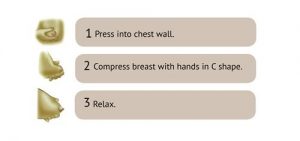Breastfeeding: Days 1-3
Breastfeed frequently
For the first few days after birth, expect your baby to breastfeed often. There should be no time limits on breastfeeding. If you are in hospital, have your baby room-in with you. Keep your baby skin-to-skin for most of the day. This way, anytime your baby looks for the breast, it will be right there ready. Watch your baby and not the clock. This helps you learn your baby’s feeding cues and early signs of hunger.
During the first three days (and in your third trimester), your body produces a type of milk called colostrum. It is small in amount but rich in vitamins, proteins, antibodies and antiviral substances. Many people call colostrum the baby’s first immunizations because it gives a boost to their immune system. It also acts as a laxative and helps your baby clear out his first bowel movement – called meconium. Meconium is a black, tar-like, sticky substance. After your baby passes meconium, stools may appear dark brown- greenish and gradually change to yellow as your milk ‘comes in’.
It is normal for breastfed babies to lose some weight in the first three days of life. Part of this is the passage of the first bowel movements and other fluids from birth.
Before your milk comes in, the baby’s urine may be concentrated with reddish-brown spots or crystals appearing on the diaper. This is normal during the first few days. Just feed your baby often. After the first week of life, the urine should be pale in colour and mild smelling.
You do not need to supplement your baby. In fact, your baby’s stomach is only about the size of a marble right now. The milk produced by your body at this time is just the right amount for your baby’s stomach to hold. Trust in your body to produce the right amount of milk to meet your baby’s needs.
For more information, please check out the ‘Signs that Feeding is Going Well’ graphic produced by Best Start Ontario.
Follow your baby’s cues
Watch for early signs of hunger, such as:
- Mouthing (hand movements to the mouth and sucking on fists.)
- Licking lips, sucking motions or sounds.
- Rooting (opening the mouth, searching to suck and sucking on contact.)
- Opening eyes wider than usual.
- Restlessness or moving arms and legs.
Your baby will also let you know when they are full. Early signs of fullness include:
- Sucking actions will slow down.
- Losing interest or letting go of the nipple.
- Rooting will stop.
- Turning head away.
Avoid artificial nipples
You can’t breastfeed too often! It is recommended that all of baby’s sucking is on mom until breastfeeding is well-established. You are all the food and comfort your baby needs. Using artificial nipples in the early days can cause your baby to breastfeed less often which may delay your milk ‘coming in’ as it should.
Having trouble?
Some mild tenderness when your baby first latches can be normal, but breastfeeding should be pain-free by the end of the first week. See your health-care provider if pain is:
- severe;
- lasts more than a few seconds;
- lasts between feeds; and/or
- combined with broken or cracked skin.
Some babies have trouble latching in the first few days. If this is the case, ask for help from your hospital nurse. If you are at home, ask for help from your public health nurse or doctor.
If your baby is having difficulty latching, keep your baby skin-to-skin as much as possible, hand express your colostrum (pumps may not work as well in these first few days before your milk ‘comes in’) and feed your baby your colostrum with a small spoon, a cup, or a medicine dropper. A warm compress (i.e. a warm towel from the dryer) may help you relax and get the milk flowing.
Hand expression
Hand expression is a very effective way to stimulate your breasts and remove your milk. Hand expressing colostrum or breastmilk is important because it helps to:
- Get baby interested in latching – express a few drops on your nipple so that your baby sees, tastes and smells the milk.
- Prevent soreness – gently rub a few drops of milk onto your nipples as this may ease any tenderness.
- Help your baby latch on if your breasts are full – expressing will soften your breasts and make it easier for baby to latch.
- Give you comfort – expressing your breasts will make them more comfortable if they are full and your baby is not feeding.
- Collect milk to give your baby – if you are going to be away from your baby, you can express milk if there is a need to feed other than directly at the breast.

For more information about hand expression, please watch ‘The Basics of Breast Massage and Hand Expression’ video from Maya Bolman and Ann M. Witt (2013).
Continue to information about Breastfeeding Days 3-5.
Services related to this information:
- Contact your Public Health Nurse.
- 811 HealthLine (Newfoundland & Labrador) – Call 811 or 1-888-709-2929 / TTY 1-888-709-3555
